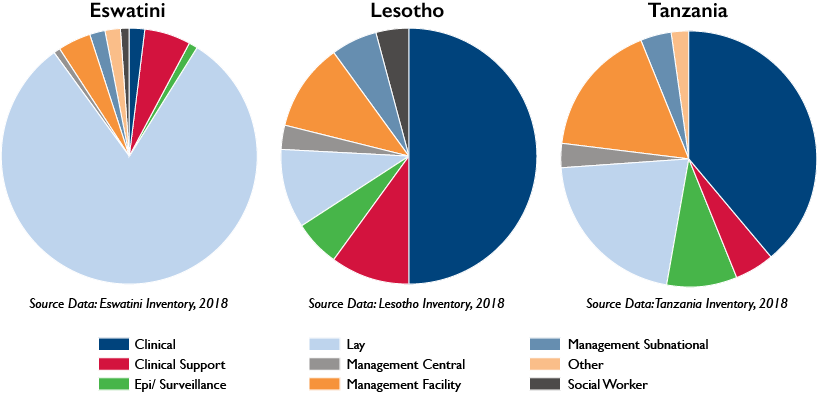
04 Dec Understanding the Donor-Supported Human Resources Needed to Achieve Sustained Epidemic Control
Throughout sub-Saharan Africa, chronic underinvestment in human resources has jeopardized efforts to achieve sustained HIV epidemic control. To accelerate policies to realize the 95-95-95 goals[1], development partners, including the U.S. President’s Emergency Plan for AIDS Relief (PEPFAR) and the Global Fund to Fight AIDS, Tuberculosis and Malaria (GFATM), have stepped in to support thousands of health and social workers, from clinical to lay cadres, across a number of countries. PEPFAR and the GFATM have made significant investments to supplement the budgets of governments either to hire additional, contracted staff or to amplify the reach and effectiveness of existing staff through overtime pay, support for outreach activities, incentives, and skills development.
To better understand the scope and nature of donor-supported investments in the health workforce, USAID’s HRH2030 has supported countries in building an HRH inventory of donor-supported workers and dashboards to analyze these investments. An HRH inventory and dashboard was developed in close collaboration with PEPFAR in Tanzania—a country that has been cataloguing and analyzing its PEPFAR-supported health workforce since 2013. In 2018, the HRH inventory was deployed in Tanzania to track PEPFAR-supported investments in over 16,000 healthcare workers nationally and was expanded to include investments by PEPFAR as well as GFATM and other donors in Eswatini and Lesotho. The HRH inventories in all three countries have increased understanding of the donor footprint in HRH remuneration support in countries.

The HRH inventory provides countries with a wealth of information about donor investments in HRH, from the job titles of health workers supported to the names of facilities where health workers are based, and includes detailed information on health worker gender, experience, compensation, and professional development. It also includes a mapping of donor-supported workers to host government cadres and pay bands, where available, to inform stronger alignment of donor support. To support the analysis of these data, the HRH inventory includes a user-friendly dashboard that supports development partners and governments to more easily track and analyze investments in HRH staffing, down to the site level, that can be utilized for sector-wide performance monitoring and program planning. In Eswatini, Lesotho, and Tanzania, the HRH inventory provides important insights into the level of HRH investment and different types of health workers that are needed to support governments’ HIV policies and accommodate differentiated service delivery models (see figure). In Eswatini, a country advancing towards HIV epidemic control, the HRH inventory is playing a role in shaping government-led analysis of and plans for transition of donor-supported HRH.
PEPFAR countries at all different stages of addressing the HIV epidemic will benefit from performance monitoring and program planning that fully account for investments in HRH support. The inventory and dashboards are available to countries as a resource to take stock of their investments in HRH. HRH2030 is also working with PEPFAR to link the inventory to MER indicators, to analyze the impact of HRH investments on performance.
To download a copy of the tool, please visit the PEPFAR Solutions Platform.
***
[1] To test 95 percent of all people living with HIV, place 95 percent of those testing positive on continuous anti-retroviral therapy (ART), and have 95 percent of those on ART virally suppressed by 2020





